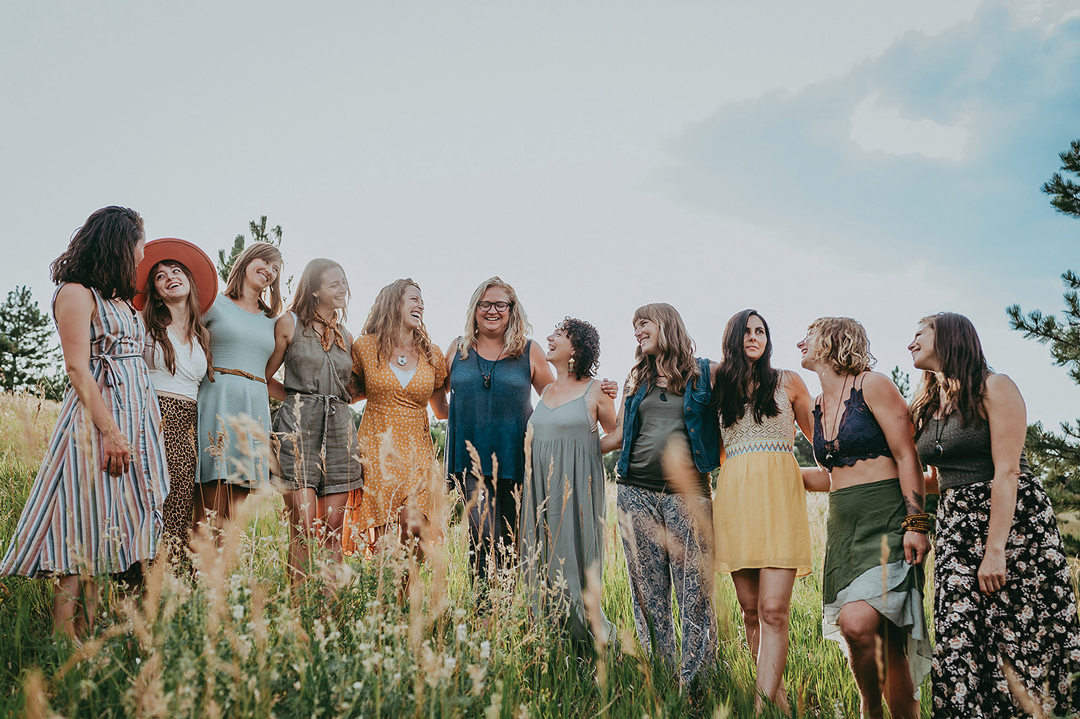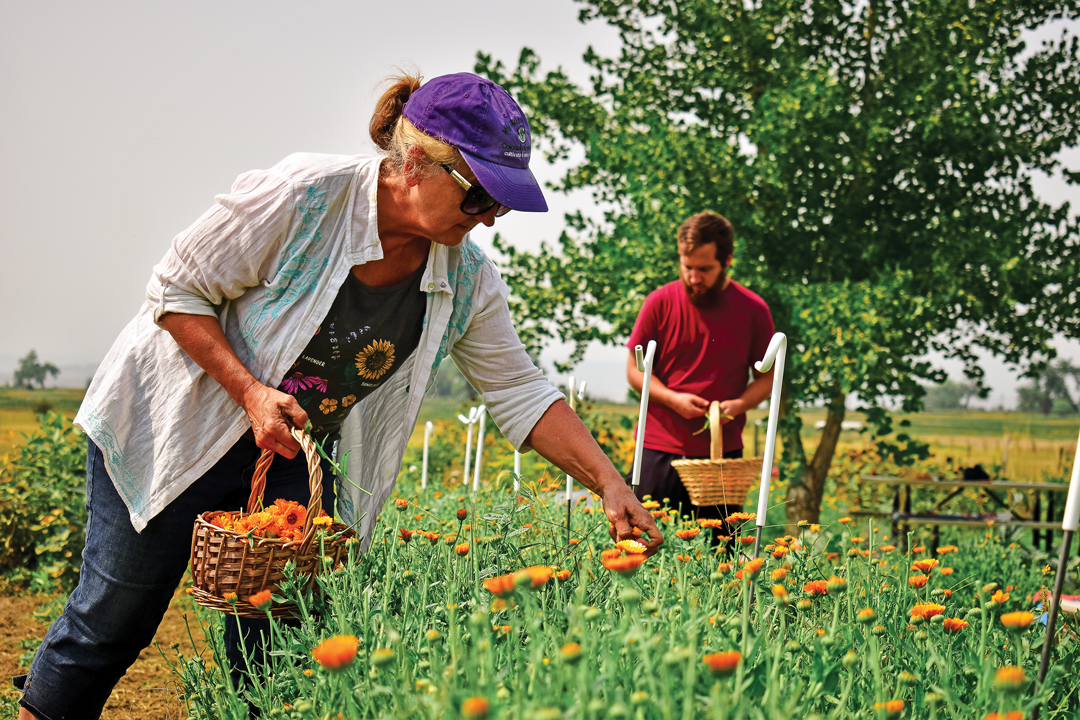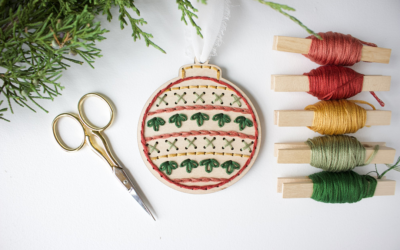Sarah Josey was studying biochemistry at Colorado State University when she learned about herbalism, a plant-based approach to wellness. As it turns out, the two have some things in common.
“Pharmaceutical companies have been researching plant medicine for years because that’s where all the amazing compounds are,” she says. “The plants have so much to offer.”
Josey is now the owner of Golden Poppy Herbal Apothecary, a shop in downtown Fort Collins she opened in 2012 after graduating from the Colorado School of Clinical Herbalism. She offers specially formulated teas, skincare products and more using certified organic herbs, plus one-on-one consultations for anyone in need of a customized herbal protocol.
When Josey started Golden Poppy, she says the world of herbalism was small and somewhat unknown. That has changed over the last decade as more people like her have discovered the power of plants for countless uses, including skincare.

Sarah Josey (fifth from left) and her staff. Photography by Sunshine Lady Photos.
Herbs for skin
A lot of herbs shine when it comes to skincare, says Cindy Jones, owner of Colorado Aromatics, a line of botanical skincare products made with plants from her Certified Naturally Grown farm in Longmont. Jones has a doctorate degree in biochemistry and was drawn to herbs for their wide range of medicinal properties, particularly for the skin.
Jones, like many in Colorado who spend a great deal of time outside, began to notice the damaging effects of the state’s harsh sun, wind and changing seasons on her skin. Dryness, signs of aging and sun damage, such as hyperpigmentation, are especially common given our close proximity to the sun, she says.
She read books, attended classes and began formulating herbal skincare products as a hobby to address those issues. In 2007, she bought the farm to have a place to grow her own ingredients and develop a skincare line.
Now Jones grows about 30 different herbs that are beneficial for the skin, including rose, yarrow and more than a dozen varieties of lavender. While each herb has a range of uses, she believes there is one winner: calendula.
“Calendula has so many beneficial properties: It will stimulate collagen production and brighten the skin, and it helps control sebum, so it’s really good for oily skin as well as very dry skin,” she says.
Many of those benefits are due to the carotenoids in calendula’s bright yellow-orange flowers, which provide powerful antioxidants, Jones says. Another compound in calendula, allantoin, is responsible for stimulating healthy skin cell reproduction, Josey adds, resulting in more rejuvenated skin.
While calendula is often used in beauty serums, it’s also considered a wound-healing herb that can repair cracks, calm rashes and reduce the appearance of scars, says Ali Bockelmann, a clinical herbalist who opened The Stinging Nettle Apothecary in downtown Loveland last September. Known for her product line, Rooted with Ali, Bockelmann creates herbal formulas using certified organic and ethically wild-harvested herbs. She also offers one-on-one consultations that can “get to the root” of various issues.
“Calendula is a beautiful skin herb, and it’s also one of our greatest digestive herbs,” she says, noting the link between internal systems (like the gut and liver) and skin health. “It helps heal our gut lining and internal tissues.”
Another well-loved herb for skincare is rose. One of Bockelmann’s favorite applications is rosehip seed oil, which is rich in antioxidants and Vitamin C, two elements that brighten the skin and reduce the signs of aging, like fine lines and wrinkles. Vitamin C is essential for the body’s process of creating collagen, Jones says.
Dried rose petals, on the other hand, are known to firm the skin due to their mild astringency, Josey says, and they can tighten pores and even help control eczema. Rose is also soothing, so it can be used by anyone with sensitive, inflamed or irritated skin.
“As people age, our skin tends to get more sensitive, and redness and fine lines start to appear,” Josey says. “That’s where rose can be really beneficial.”

Cindy Jones gathering calendula flowers.
Using skincare products
While many subscribe to complicated skincare routines, Bockelmann says most people need only a handful of products—such as a cleanser, toner, moisturizer and, of course, sunscreen—to start seeing results. Facial toners are one of her favorite products to start people off with because they help rebalance the skin’s pH level after cleansing.
“When we wash our face, we strip all of our natural oils, so the pH of our face becomes imbalanced and we experience things like acne,” she says. “Using a facial toner restores the pH balance. You want to rebalance that before you put things on your face.”
Bockelmann sells a three-in-one facial toner made with rose hydrosol—the aromatic water byproduct of essential oil distillation—and several other ingredients to tone and hydrate the skin. Jones also offers a variety of face and body mists made with hydrosols, which she says capture the antioxidant compounds of the plants they are distilled from. She suggests spraying them on your face before rubbing in an oil-based moisturizer to increase the skin’s hydration.
As fall approaches, along with cooler days and more sunny, windy hikes to see the changing leaves at a higher altitude, Jones recommends applying a face cream to help protect and moisturize the skin. For example, her Springtide Gold face cream is made with antioxidant-rich ingredients, like raspberry seed oil, that help prevent and repair sun damage while supporting the skin barrier. For even greater protection, her Aspenglow facial balm has a waxiness to it that keeps the wind off your skin.
Josey likes switching to a heavier face cream in the fall to replace the moisture lost in the colder months. Her thickest face cream, Queen of the Night, uses jojoba oil infused with rose, helichrysum, calendula and gotu kola, among other ingredients that provide intense moisture. For those who prefer a lighter feel, her Rose Face Frosting has a fluffy texture and is packed with antioxidants. But her favorite facial moisturizing product is her Rocky Mountain Recovery oil, which is made with calendula, rosehip seed and other nourishing herbs.
“It’s good for people with dry skin as well as people with an overproduction of oil,” she says. “Dryness sometimes causes the skin to become more oily because it’s overproducing oil in response. I tell people, ‘Trust me, you need to put oil on your body so it doesn’t feel like it has to make so much all the time.’”
For those with dry, cracked hands, Bockelmann offers three herbal lotion bars that melt to the touch: one with lavender, one with cocoa butter and one with arnica (for pain relief). All three herbalists make salves with wound-healing herbs, like calendula, plantain and comfrey, to repair and strengthen the skin.
“Salves are usually medicinally used, providing relief for minor cuts and scrapes but also skinned knees, rashes and even fresh tattoos,” Bockelmann says. “The body naturally wants to heal, so it’s about giving people the resources they need to have autonomy over their own body and health.”
Skincare Favorites
Many herbs are known for their skin-healing properties. Here are a few our sources recommend looking for on ingredient labels—and in local apothecaries when creating your own skincare products.
Fennel
Jones uses fennel in some of her skincare products as a moisturizer.
“Fennel brightens the skin and helps it hold moisture,” she says. “It also helps with hyperpigmentation.”
Frankincense
Frankincense is a medicinal resin that can be infused into an oil, Josey says.
“It’s really high in antioxidants. Topically, it helps prevent and reduce the potential for oxidative damage from the sun, like sunspots,” she says.
Plantain
Like calendula, plantain is a wound-healing herb, Bockelmann says.
“It’s great for bee stings. You can take a leaf, chew it up and spit it on the bee sting, and it can help pull out the stinger,” she says.
How to Make an Infused Oil
Courtesy of Cindy Jones, owner of Colorado Aromatics
Anyone can make their own infused oil from herbs grown in the garden. Infused oils can be used topically as a body oil or to add to your bath.
Here’s how:
1. Make sure your herb is completely dry. Moisture can cause spoilage or mold, so ensure that the herb is thoroughly dried before use.
2. Weigh 15 grams of the dried herb into a small jar using a kitchen scale.
3. Add 150 grams of carrier oil to the herb. You can use olive oil, almond oil, sunflower oil or another oil of your choice.
4. Stir or shake to mix well.
5. Press the herb down gently to make sure it’s fully submerged in the oil. Put a lid on the jar.
6. Let the mixture steep for at least two weeks. This allows the oil-soluble compounds to infuse from the herb into the carrier oil. Store it in a cool, dark place and shake it occasionally.
7. To filter, place a piece of cheesecloth in a funnel over a clean jar. Slowly pour the infused oil through the cheesecloth to strain out the herbs.
8. Store the filtered oil in a clean, dry, airtight container. Use as needed.







